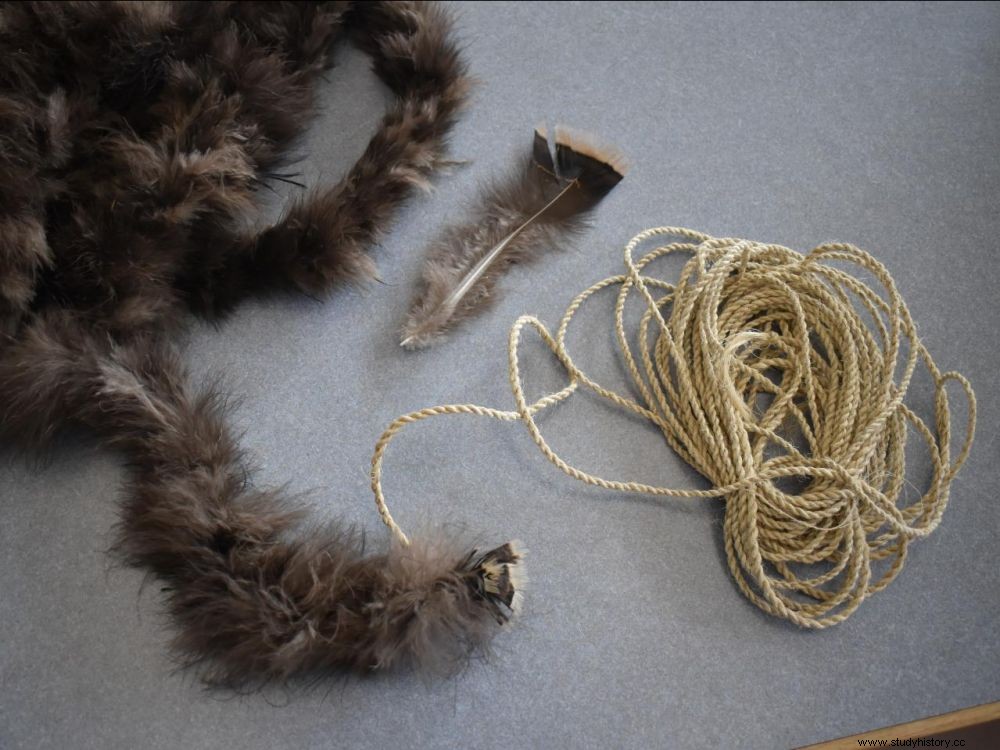American researchers have studied an 800-year-old turkey feather blanket. Such objects were used by Pueblo Indians to cover infants as well as the dead.

A segment of fiber rope that has been wrapped in turkey feathers.
In a new study published November 29, 2020 in the journal Journal of Archaeological Science:Reports , American researchers shed new light on the development of turkey feather blankets in the present-day southwestern United States several centuries ago.
11,500 feathers from four to ten turkeys
One of these blankets is the subject of this new study. This one, 800 years old, has a dimension of 99 centimeters by 108 centimeters. It was found in southeastern Utah and was crafted by the ancestors of today's Pueblo Indians. The study of the object revealed that it had been made using 11,500 feathers taken from four to ten turkeys, it all depended on the length of the feathers. Once removed, these dander were placed on 180 meters (!) of yucca fiber rope. They thus made it possible to form the framework of the cover. Information gathered so far suggests that these products were made by women and were used as cold weather coats, sleeping quilts, and eventually burial covers.
In a new study published November 29, 2020 in the journal Journal of Archaeological Science:Reports , American researchers shed new light on the development of turkey feather blankets in the present-day southwestern United States several centuries ago.
11,500 feathers from four to ten turkeys
One of these blankets is the subject of this new study. This one, 800 years old, has a dimension of 99 centimeters by 108 centimeters. It was found in southeastern Utah and was crafted by the ancestors of today's Pueblo Indians. The study of the object revealed that it had been made using 11,500 feathers taken from four to ten turkeys, it all depended on the length of the feathers. Once removed, these dander were placed on 180 meters (!) of yucca fiber rope. They thus made it possible to form the framework of the cover. Information gathered so far suggests that these products were made by women and were used as cold weather coats, sleeping quilts, and eventually burial covers. "While the ancestral farming populations of the Pueblo thrived, several thousand feather blankets would likely have been in circulation at any one time, notes in a statement Shannon Tushingham, co-author of the study and assistant professor of anthropology at Washington State University. It's likely that every member of an ancestral Pueblo community, from infants to adults, had one ". More durable than those made of rabbit skins, they could be used for years. Even today, these objects are precious:few of these textiles have come down to us because of their perishable nature. They are more stored in extremely cold and dry places.
Animals of paramount importance to Native Americans
This study also looked at the economic aspect of the production of these blankets. A sustainable supply of feathers was probably ensured by the collection of feathers from living birds, during moulting periods or not. Samples from recently killed animals may also have taken place, but this practice was less common. "It may be possible to infer the method of obtaining by determining whether traces of blood in the cover indicate whether a feather was collected after it matured or whether it was obtained by premature picking from a live bird ( or dead) “, explain the authors of this study.
Before wild game was depleted in the area due to hunting around the 1200s, these turkeys were not a food source. Archaeological excavations have unearthed whole skeletons of these mature birds, intentionally buried, suggesting some sort of ritual. Even when these turkeys were raised further for food, their remains were buried. "When the cover we analyzed for our study was made, we think of the early 1200s CE, the birds that provided the feathers were probably treated as important household individuals and would have been buried completely “, remarks Professor William Lipe, lead author of the study. And to add:“this reverence for turkeys and their feathers is still evident today in Pueblo dances and rituals ". These animals were among the first to be domesticated in North America until the arrival of Europeans between 1500 and 1600 years ago and the use of sheep and chickens. They had considerable importance for the Pueblo tribes.
